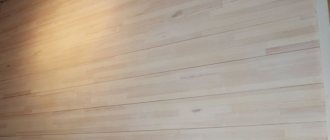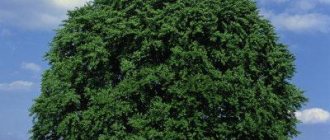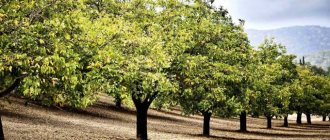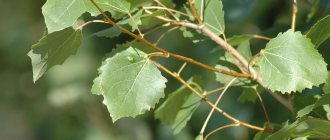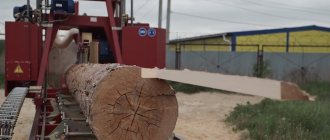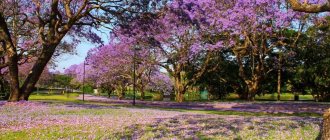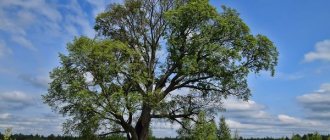CONIFEROUS TREES
Pine.
Belongs to soft species, the wood is straight-grained with a yellowish tint, dense and durable, with medium drying properties. It is easy to process, if not very resinous, and glues relatively well, but is poorly finished and painted. Not very suitable for small relief carving. Often used for carved house decorations.
Spruce.
The wood is soft, light, shiny, has an exceptionally uniform distribution of fibers, and cracks well. It is lighter than pine, not as resinous and inferior to it in strength. Spruce wood is used to make violins and other stringed instruments because no other tree gives such resonance as spruce.
Larch.
Its wood has no equal. It is very heavy, durable, difficult to process, but durable. In Germany, Poland, and other European countries, buildings made of larch logs have been standing for more than 500 years. A valuable quality of larch is that it does not rot from dampness. The buildings of the city on the water were erected on larch stilts back in the Middle Ages and still stand today. Larch is also suitable for parquet - durable, beautiful, naturally reddish, it does not need painting.
Tiss.
Heartwood with narrow yellowish-white sapwood, sharply limited by a brownish-red core; the annual layers are sinuous and clearly visible in all sections. The wood is dense, hard, heavy, and almost does not rot. Well processed, painted and polished. This is one of the best materials for carpentry, finishing and turning. Yew wood is amazingly beautiful in color - pink, red, crimson-violet to deep black. Thanks to the color and waviness of the annual layers, it has a beautiful texture in tangential sections. Yew is one of the hundred tree species that are called “mahogany”. Large burls often form on yew trunks, the wood of which is highly valued as a finishing material and for making small plastics.
Common juniper (shrub).
A soundwood without resin passages, having a narrow pinkish-white sapwood and a light yellowish-brown core, often delimited from the sapwood. The annual layers are wavy, noticeable on all sections: early wood gradually turns into late wood. The heart-shaped rays are not visible. The wood is heavy, durable, hard, dries out little, is resistant to rotting, retains a pleasant smell for a long time, can be easily processed with a cutting tool, and can be easily tinted and polished. The cuts are clean and glossy, with a very beautiful texture. Dried juniper - trunk, branches, roots - is an excellent material for carving, turning and carpentry. Such wood is much more beautiful when cut than that of a living tree. It does not need to be specially dried, since it has already been aged for years in the forest. Juniper wood is successfully used for very fine flat-relief and volumetric carvings, various artistic products, and decorations.
Cedar, fir wood
its structure is close to pine wood and is widely used for carving work. The striped texture of coniferous wood looks good on smooth polished surfaces: panels, background boards and panels in the form of an oblique cut, vases, plates, lamps made from boards with slotted carvings, in other products with contour carvings, when the decisive factor in the form is not the relief, but silhouette.
Wood structure
By making a cross section, you can most clearly examine the structure of the wood. Each block of unhewn wood has bark - this is the skin of the tree, which is not used in work; it must be removed.
Under the bark there is a tree growth zone, which is practically invisible to the naked eye. On a fresh cut from a growing tree, this cambium layer is very well represented. After you remove the bark, you will be exposed to a thin layer of moist greenish tissue - this will be the cambium. Behind the cambium is the actual wood with growth rings.
The wood is also called sapwood. In the center of each tree there is a heartwood, which can be the same color as the sapwood or have a darker color. Depending on this, sapwood species are divided into sapwood, where the core does not have a pronounced structure and the cells are located as densely as in sapwood, and heartwood, where, accordingly, the core is clearly visible. Sometimes sapwood is called coreless wood.
Sound tree species include all conifers (pine, cedar, spruce, yew, larch) and some deciduous species, such as oak, ash, poplar.
The majority of deciduous species are sapwood, or kernel-free: birch, hornbeam, alder, maple, hornbeam. In addition to the microstructure of wood, which includes the density of wood cells, the creation of a composition and the possibility of using a particular block in work is influenced by the macrostructure of wood, represented by growth rings and heart-shaped vessels. The macrostructure also includes the presence of various knots, growths and undeveloped shoots-eyes, which deflect the growth rings and form various curls.
Wood, where growth rings, horizontal and vertical vessels are most clearly distinguishable, seems to be the most interesting for processing. Almost all coniferous species - hornbeam, oak, elm, beech - have such wood.
deciduous trees (ring-vascular)
Oak.
The wood is strong, dense, has an expressive texture, dries out moderately, cracks and warps a little, and is practically not susceptible to rotting. Oak kept in water for a long time acquires a black color and becomes very hard. In the past, expensive furniture was made from stained oak wood. Oak can be easily painted and tinted using mordants and finished with mastics. Processing oak wood requires great strength and well-sharpened tools. Oak is widely used for carving, turning, veneering, and mosaic work.
Ash.
The wood is characterized by high strength and toughness, low tendency to cracking, and good bending ability. It is easy to process, changes slightly in volume when dried, and is perfectly polished. The wide sapwood has a beautiful light yellow color and a beautiful grain pattern. In combination with a dark brown core it looks very impressive. Ash wood is valued on a par with mahogany. Ash plywood is used to decorate furniture and musical instruments. The growths on ash - burls - are used to make small but valuable crafts.
Elm.
Its wood with yellowish-white sapwood and a dark brown core has a beautiful structure, is strong, hard, elastic, bends well, is tough and durable. Used in carpentry work. Burls on elms - burls - are highly valued for turning crafts.
White acacia.
Heartwood with very narrow yellowish sapwood, sharply demarcated from the green-gray or yellowish-gray core. The earlywood zone is occupied by a ring of large vessels; small vessels in late wood form groups in the form of dots, dashes or short winding lines. Wood with beautiful texture and color. In terms of physical and mechanical properties, it is significantly superior to oak and ash. Rot resistant.
Mulberry.
Wood with very narrow and yellowish-white sapwood, sharply separated from the reddish-brown core; in the light it darkens and becomes dark brown. The vessels form groups of light dots on the section; the medullary rays are narrow, but clearly visible. The wood is hard, heavy, with beautiful texture, color and shine.
Apple tree.
The wood is hard, heavy, of uniform structure, quite viscous, and has high strength and wear resistance. Drying it is not easy, as it dries out a lot, but then the product never cracks or warps. The wood can be painted well, sanded, polished and polished well. Impregnated with linseed oil or drying oil, it acquires greater strength and a deep dark brown color. The wood of apple trees growing in a helical shape, the butt part of the trunk and roots, has an original texture. Cutting tools leave a smooth, glossy cut on the wood. Apple wood is especially good for fine carving of miniature sculptures.
Rowan.
The wood is reddish-brown in color, difficult to process, but has high strength, heavy and hard. Freshly cut rowan should be dried carefully, in a gentle manner, as it dries out greatly. Products made from rowan can be easily painted, etched, sanded and polished, acquiring a beautiful silky shine. Dense and uniform rowan wood is an excellent material for turning and carving work. Durable, with an expressive curled texture, rowan wood was previously widely used for carved and slotted products (loom parts, bowls, spoons, ladles). Rowan root is an excellent material for sculpture, and the branches are flexible enough for weaving.
Bird cherry.
The wood is heavy, strong, dense and flexible, is resistant to moisture and does not warp or crack when dry. Easily etched, painted and polished. Young wood is white, old wood is red-brown, and has the smell of almonds. Although bird cherry wood dries out little, it should be dried carefully so that it will not crack or warp. Due to the homogeneity of the structure, it cuts perfectly in all directions, and when polished it acquires a glassy shine. It has always been popular with carpenters, turners, and woodcarvers.
Hazel.
It has long been used for small turning, carpentry, and carving work. Chess sets, pencil cases, pencils, shuttles, pipe stems, and tool handles were turned and cut out of it. Thin, flexible strands were used for weaving, hoops, and fishing rods.
Lilac.
Wood with a beautiful texture, when painted with a weak solution of hydrochloric acid, acquires a purple color.
Wood of buckthorn, honeysuckle, hawthorn
hard, bone-like, does not crack, polishes well.
Wood defects
When working with wood, you should not only pay attention to the location of the fibers. First of all, carefully examine the block you have chosen from all sides. The wood you are going to work with must be not only durable, but also “healthy” - uniform in color, without admixture of interesting and unusual colors, without signs of damage by wood borers, and also without signs of rotting. If your block has at least one of these signs, then immediately put it aside, otherwise you may suffer from everything while working, and at the end of the work you will not receive sufficient satisfaction from the work done. And the work may simply come to nothing.
Wood affected by fungus should not be used for work. It can be clearly seen even with the naked eye by a change in the color of the wood and by the splitting of wood fibers at the site of the lesion. The color of wood affected by fungus can vary: from cream and brown to bluish and greenish. The rest of the wood will retain its usual color.
Greenish coating
, which appears on certain areas of the wood, indicates that the wood has begun to rot. Mold affects wood only from the outside, so if you clean the surface in a timely manner with a knife or plane, the board or block can still be saved, and then, after drying it, used in your work.
Color rot
not as harmless as sound. It attacks wood from the inside, destroying its structure and making it impossible to use. Wood can be absolutely healthy, but still unsuitable for work. Defects can be different. Some of them can completely eliminate wood from use, while others only limit processing capabilities.
The most common defect is the presence of knots. But there are two types of knots. Some of them are firmly fused with the wood and are removed from the massif only when the entire area is removed. Others separate from the wood easily. This is where there is a high probability that when drying a finished product, it may fall out and ruin the whole picture.
Such a hole can be sealed using a wedge-shaped plug, which is driven in instead of a knot. In addition, when wood is stored for a long time as a building material, the knots darken first. The only exceptions are some coniferous species.
The category of wood defects also includes the presence of tar in coniferous trees and water layers in deciduous species. This is the common name for places where tree sap accumulates in solid wood. When finishing, you will have to pump out the resin from this place and treat it with a special solution. But it’s better if you place the part on the block so that the pocket is either inside the part or outside it.
Among the defects of wood that must be taken into account when working, the most important defect is the presence of cracks. They are formed in solid wood during the growth of the tree trunk. Cracks can be different.
Frosty
cracks can divide the entire trunk into two parts. The cracks themselves go from the outer edge inward and form only in winter during severe frosts.
Compensation
cracks occur only inside the trunk, creating a gap between the growth rings. The reason for the formation of such cracks is high stress inside the trunk during a period of increased growth.
Methic
cracks, like frost cracks, can divide the trunk into two parts. The difference between them is that frosty ones go from the outer edge to the center, and metic ones go from the base of the trunk to the top.
Cracks during drying can also form in wood without visible defects. Such cracks run from the center of the trunk to the outside across the growth rings.
Wood defects also include the presence of inclined fibers. Such a defect can be either natural or mechanical. In any case, thin narrow pieces of such wood warp very much when dried.
In coniferous wood, the most common defect is tilting. This is a natural defect that occurs when the trunk is compressed during the growth period. The wood fibers in this area are located close to each other, which significantly increases the time it takes for the wood to be impregnated with antiseptics and chemical dyes. But such wood is very durable and resistant to weather conditions, so it can be used for upholstering the front door in a country house or apartment.
The presence of growth in the wood is harmless in itself, but can create great difficulties after drying. This defect occurs when a tree trunk is cut during growth. The resulting wound gradually heals, but the annual rings begin to grow differently.
deciduous tree species (disseminated vascular)
Linden.
The wood is soft, light, and quite viscous. Due to the homogeneity of the structure, it is perfectly processed in all directions by hand and on a lathe, and holds its shape well. It is widely used for the manufacture of objects decorated with relief openwork and sculptural carvings (however, they try not to make small carvings from linden). Linden does not crack, sticks well, is painted, and is satisfactorily polished.
Aspen.
The wood is soft, light-colored, not straight-grained, but easy to work with, and bulges when planed. It cuts well with a chisel and is easily polished across the grain. Wet wood is difficult to saw along the grain. The color of aspen can be pure white or greenish, which is important when making mosaics (marquetry) and inlays (intarsia). It is not afraid of moisture, does not warp or crack. It does not prick from impact, peels well, and glues securely. Light toys, dishes, and other small objects are made from it and decorated with carvings. Aspen aged for several years is perfectly sanded and polished.
Alder.
The wood is light, soft, moderately drying, exhibits slight warping when drying, can be cut, glued, painted and polished well. Used for carving work, as well as to imitate ebony and mahogany, walnut. The natural color of alder is from white to pale brown; in air it quickly changes to red-brown.
Poplar.
The wood is light, soft and dimensional-resistant, can be processed and glued well, and is finished satisfactorily. Low resistance to rotting. Color - from whitish, yellowish-brown to red-brown. The texture is beautiful, large-layered. Of all the varieties of poplar, silver poplar is valued.
Willow.
Heartwood with wide white sapwood, vaguely demarcated from the brownish-pink core. The wood is loose and therefore light, fresh, very soft, and is used for small outbuildings. Willow is good for weaving baskets, furniture, and mats. Talnik, krasnotal, belotal, chernotal, willow, willow, willow, shelyuga - this is not a complete list of popular names for various types of willow.
Common birch.
The wood is of medium density and hardness, uniform in structure, strong, quite tough, easy to cut in all directions, drills, glues, polishes and paints very well. Disadvantages: Susceptibility to cracking, warping, severe shrinkage, wormhole damage and rotting. The wood of the warty and downy birch is highly durable; its hardness is on the border between soft and hard species.
Karelian birch.
In appearance it does not differ from ordinary wood, but its wood is completely different: light ocher in color, it is densely “painted” with small dark inclusions, which create a moire shimmer against the mother-of-pearl background. The combination of broken heart-shaped rays and wavy growth layers gives a beautiful mottled surface in section. The wood is viscous, cuts well, and almost does not crumble.
Beech.
Nuclear-free breed. The wood is white with a yellowish-red tint; annual layers are clearly visible in all sections; the heart-shaped rays are wide and narrow. It is distinguished by high strength, beautiful texture in a radial section, but is poorly resistant to rotting. In terms of mechanical properties - density, strength, hardness - beech is close to oak. In the steamed state it lends itself well to bending. Due to its beautiful texture, it is used for the production of planed veneer, parquet friezes, musical instruments, mosaic works, carvings, imitation of rose and mahogany, and walnut.
Walnut.
One of the few breeds with a rich range of colors and tones and a variety of textures. Color - from light brownish-grayish tones to gray-brown, almost black. The wood is moderately hard, does not dry out much, holds its shape, is easy to process, cuts perfectly in all directions, glues and finishes well. Used for various carvings, mosaics, and cladding.
Hornbeam.
The wood is white with a grayish tint, shiny, heavy, strong, tough, often twisted, difficult to chip, cut, difficult to polish, but easily painted, imitating ebony. Used for making musical instruments and various crafts.
Sycamore.
The wood is light and moderately hard, but its heterogeneous structure makes it difficult to process. It is one of the most decorative. Wide and fairly frequent rays on a cut of wood form an unusually beautiful texture, so well-polished products look very elegant. Used for making parquet, furniture, valuable crafts.
Pear.
The wood is dense, strong and hard, practically does not warp or crack, it is well processed, glued, painted and finished. After tinting it imitates ebony. The pear is used mainly for small and medium carvings with complex relief, for applied and openwork carvings, and mosaic work.
Maple.
The wood is not only dense, strong and hard, but also beautiful. Its structure is thin, and the white heart-shaped rays shine, especially in a longitudinal section. It is difficult, but evenly pricked, well processed, glued, and painted. Mainly used for carving work (especially for overhead carving). Bird's eye maple is good for inlaid decoration in marquetry and for veneering. The “streamy” maple wood with its wavy grain and burl pattern is also highly valued.
Red tree.
A number of tropical wood species (mahogany, sangwood, etc.). The wood is red, red-brown, light cherry or light pink in color, with a red texture, very durable, and polishes well. It has long been used to make high-quality furniture. Sometimes the wood of yew, black alder, and sequoia is called mahogany.
Ebony.
Several species of tropical trees, mainly of the ebony family. The wood is dark or black in color, very dense, heavy, durable, and easy to process. It is used to make valuable furniture, carved and turned items, and musical instruments. The wood of hornbeam, boxwood, yew, plum, and birch can easily be finished as ebony. Black wood has bog oak.
Source
Deciduous trees
Acacia
Photo:
Acacia belongs to the genus Robinia of the Legume family. There are more than 600 species of this plant in the world. On average, the height of the tree reaches 25 meters, but sometimes shrub-like representatives are also found.
Important! All parts of acacia contain a toxic substance - the alkaloid robinine, so it is not recommended to use it independently for therapeutic purposes.
The homeland of acacia is North America, but today the tree grows in countries such as New Zealand, African countries, and Europe.
The foliage is ovoid in shape. The upper part of the plate is green and has a smooth structure, and the bottom resembles velvet, gray-green in color.
The flowers of the plant are predominantly white or yellow and smell pleasant.
Let's look at the most common varieties:
street acacia
The variety is resistant to environmental pollution and fast growing. The height of the tree is 15-25 m, width - 8-10 m.
It has alternating, odd-pinnate leaves, the length of which can reach 15 cm, painted dark green. The flowers are white, have a pleasant aroma, and are about 20 cm long.
The variety blooms in late May - early June. Street acacia is not too demanding on the soil, but if planted in damp, heavy soil, it may suffer from frost. Prefers sunlight and tolerates drought well.
Golden acacia
The height of trees of this variety is on average 9-12 m. They have medium size, openwork foliage. The flowers are painted white, collected in brushes, the size of which is approximately 20 cm. The variety blooms in late spring - early summer.
The fruit is brown, rather flat, 5-12 cm in length. The foliage has an obovate shape and blooms late. In spring and summer there is a light blue-green color, and in autumn it is light yellow. The variety grows very well in sunlight and tolerates drought.
Silk acacia
Plant height - 6-9 m, width - 6-7 m. It has an umbrella-shaped spreading crown and dark green bark. The leaves bloom quite late - in May.
The foliage begins to fall late - in November. It is openwork, length - 20-40 cm. The flowers are yellow-white, blooming in July and August. Grows well in neutral soil and well-lit areas.
Birch
There are about 120 species in the family. Birch has a smooth bark that peels off thinly and has alternate, petiolate leaves. The flowers are represented by staminate centers, and the fruit is a flattened single-seeded nut, which contains two membranous wings.
The most common varieties include the following:
Dwarf birch
Photo:
The place of growth is Western Europe. It is found in the tundra, alpine belt, moss forest swamps, wet and poor acidic peat bogs. It is a shrub whose height does not exceed 120 cm.
The diameter is always approximately the same as the height. It has a creeping crown shape and a superficial root system. Growth is slow. Prefers acidic and slightly acidic soil. Planting is recommended in the fall.
The foliage is round, the width can be greater than the length (length - 5-15 mm, width - 10-20 mm). The leaves are colored green. The inflorescences are represented by centers, the length of which is 5-8 mm, and the fruits are elliptical nuts. There is good frost resistance.
Swamp birch
The tree is of medium size - the height is no more than 20 m. The branches direct straight up. Young trees have white bark, which becomes gray-black with age.
The foliage is elliptical in shape, 3-5 cm long. Prefers moist and dry, sparsely sandy soils. The flowers are represented by yellow-green earrings.
Weeping birch
The tree has an elegant appearance and dense branching. It has an umbrella-shaped crown and branches hanging down, in most cases they reach the ground.
The height is about 8 m, width 4-7 m. Looks ideal in small gardens. It has round leaves, the diameter of which is approximately 2 cm, colored dark green.
In autumn they become orange-red and fiery in color. The tree is undemanding to soil, loves light, and has good winter hardiness.
Elm
Elm is a tall deciduous tree with ovate leaves that are curved at the base. The height of the plant can vary and depends on the height of the grafting. The crown is usually very wide, can reach 10 meters with a tree height of 5 meters.
It has a weeping shape. The inflorescences have an inconspicuous appearance, rather small, but the fruits are represented by large greenish lionfish. Swamp colored foliage. It grows well in moist, fertile soils, has good frost resistance, and is often found in city parks.
Let's look at the most common types of elm:
Thick elm
Photo:
It grows wild in Central Asia. The plant is quite tall - it can reach 30 meters. It has a low-lying, wide-pyramidal crown.
It has dark bark, leathery leaves, the length of which is about 2 cm. It is resistant to drought, grows rapidly in soil with high moisture content.
Hornbeam elm
It has high winter hardiness if it grows in forest-steppe and steppe zones. The height is up to 20 m, it has a spreading crown, the diameter of which can reach 10 m, and thin brown shoots.
It is distinguished by dense, marsh-colored, shiny, unequal leaves, 12 cm long and 7 cm wide. With the arrival of autumn they acquire a bright yellow color. The inflorescences are small, reddish-red. Moist, deep and nutritious soils are well suited for growing.
Androsova Elm
The height of the tree is about 20 m, it has a dense spherical crown. Old branches have gray bark, while young ones have brown-ashy bark. The foliage is ovate or rounded-ovate in shape, pointed at the top.
Leaf length is 5-6 cm. The fruits are represented by angular-rounded lionfish, up to 2.5 cm long. It has excellent winter hardiness and grows well in nutritious soils with moderate moisture.
Growth occurs quickly and tolerates drought well. Often used in landscaping parks and gardens.
Hornbeam
The tree grows on mainland Europe, Asia Minor, the Caucasus, and Transcaucasia. Its habitat covers deciduous forests.
The height of the plant can reach 12 m, the diameter of the trunk is up to 40 cm. On average, a tree can live 150 years. It has a dense crown with a cylindrical shape.
The trunk is ribbed, the branches are quite long and thin. The tree has a shallow root system, lateral anchor roots that go deep into the ground and grow slowly.
The leaves are oval, approximately 15 cm long and 5 cm wide. The upper part is dark green, the lower part is pale green. With the arrival of autumn, the foliage turns lemon yellow.
Let's look at the most common types of hornbeam:
Hornbeam pyramidal
Photo:
There is a narrow, cone-shaped uniform habit and a long apical shoot. The height of the plant can reach 15-20 m, the width of the crown is 4-8 m.
It has alternating leaves with an ovate or oblong-elliptical shape. The leaf length is 5-10 cm, width - 3-6 cm. They have a light green color, becoming bright yellow in the fall.
Eastern hornbeam
It is found in the Crimea, the Caucasus, the Balkans, Asia Minor, Iran, on dry mountain slopes and the undergrowth of coniferous forests. The height of the tree is about 5 meters, in rare cases it can reach 8 meters. Bush-like form is possible.
The growing season occurs in the second half of April and lasts until mid-October. Flowering does not occur. Has low winter hardiness.
Heart hornbeam
The natural habitat is shady, mixed forests in the south of the Primorsky Territory, China, Japan, and Korea. The height of the tree is on average 15 m. The plant has ovate leaves, the length of which reaches 12 cm.
In spring and summer they are painted light green, and with the arrival of autumn they acquire a red or pale rusty color. The length of men's earrings is up to 8 cm.
The tree is unpretentious to the soil, has superficial, highly branched roots. Under favorable conditions it can live up to 200 years. Has good wind resistance.
Oak
There are about 600 species in the genus, which grow in the temperate and tropical zones of the Northern Hemisphere.
The tree has a powerful tent-shaped crown, leathery leaves, and deep roots. Loves light, grows well in rich soils, has good wind resistance, drought resistance, and longevity.
The most common types include:
English oak
Photo:
The place of growth is the European part of Russia and Western Europe. Found in coniferous and deciduous forests on rich soils. The tree is large: height - up to 50 m, width - up to 25 m.
The fruits are represented by acorns, up to 3.5 cm, ripening in autumn. The foliage is alternate, leathery, elongated, obovate. The length of the leaf is up to 15 cm, it has an elongated apex and several pairs of lateral lobes of different lengths.
The surface of the foliage is shiny, swamp-colored, and light green in the lower part. It has good winter hardiness and is often found in city parks.
Red oak
Places of growth - forests, shores of lakes and rivers, areas where water does not stagnate. Found in deciduous and mixed forests, on low hills. The height of the tree reaches 25 m, there is a dense tent-shaped crown.
It has deep-notched, thin, shiny leaves, colored reddish when blooming. In summer they are dark green in color. Leaf length - 15-20 cm.
Acorns are tent-shaped, up to 2 cm long, red-brown in color. The species has good frost resistance and wind resistance.
Fluffy oak
The place of growth is the southern part of Crimea, the northern part of Transcaucasia, Southern Europe, Asia Minor. The height of the plant is 8-10 meters.
There is a low winding trunk and a voluminous crown. The leaf length is 5-10 cm, the shape is very diverse and variable, the upper part is painted a marsh color, the lower part is gray-green.
Growth is slow, loves light and warmth, prefers dry rocky slopes and soils with lime.
Important! It is not recommended to grow red oak in large quantities - it has too hard leaves that take a long time to decompose, forming a “film” on the ground that will prevent other plants from growing.
Willow
Willow grows in Siberia, Northern China, northern Europe, and northern America. The height of the tree is approximately 15 m, but sometimes species up to 35 m in height can be found. Willows prefer damp places, so they most often grow on the banks of rivers and lakes.
The most common types of willow include:
Willow
Photo:
The height of the plant is 5-6 m, in rare cases - up to 8 m. It has straight, long, thin, pressed branches. The length of adult leaves is 15-20 cm, width - up to 4 cm.
They have an elongated shape, the lower part is covered with silky bristles, and slightly shiny. The fruits are presented in silky, swollen capsules, the length of which is 4-5 mm. Blooms in spring, starting in March. It begins to bear fruit in April and ends in June.
Silver willow
It grows throughout Europe and Northern Asia. Can be found in damp areas, as well as sand dunes. It looks like a shrub, the height of which does not exceed 50 cm and the width - 1 m.
Growth is slow. It has thin, gray-green shoots, on the surface of which there are silky hairs. The foliage is small, oval or elliptical in shape, and after blooming it acquires a white-silver color. With the arrival of autumn, the leaves turn pale yellow.
Purple weeping willow
The place of growth is Eastern and Western Europe. The shrub has a conical crown shape. Its height is 5-7 m, width 3-5 m. The foliage has a narrow lanceolate shape, the upper part is slightly shiny and has a bluish-green color.
The length is approximately 8 cm. Flowering occurs in March - April. The length of the earrings is up to 3 cm, they are painted silver-green. Men's earrings have purple anthers.
It has good frost resistance, prefers light areas, and easily adapts to urban conditions.
Maple
The height of the tree varies and depends on its type. On average it can reach 30 meters. Maple is a long-liver - lives about 200 years. The bark is colored gray, and the diameter of the trunk can reach 1.5 m. It has large, sinewy leaves with 5 lobes and pointed lobes.
In autumn, the foliage takes on an amber color. After leaf fall, seeds that resemble dragonflies in appearance begin to fall. Flowering occurs in May and lasts approximately 10 days.
Let's look at the most common types of maple:
Field maple
Photo:
The tree can reach a height of 3 to 15 meters, a width of 8 to 12 meters. It has a wide-conical or ovoid crown shape, an average growth rate (25-40 cm annually).
It is distinguished by the presence of five-lobed dark green leaves, which in autumn acquire a bright yellow or orange color. Maple has a deep, dense, slow-growing root system, grows well in urban environments, and is wind-resistant.
Globe maple
The height of the tree reaches 5 m, width - 3-5 m. It has a spherical crown that expands gradually. It has yellow-green flowers. The fruits are not very attractive. It has five-lobed leaves that bloom in early April.
At first they are orange-red in color, in summer they become golden yellow, and the lower part is painted light green. Poor, sandy and acidic soil is not suitable for cultivation. Grows well in urban conditions and has high wind resistance.
Linden
Belongs to the Malvaceae family. The habitat is the temperate and subtropical zone of the northern hemisphere. Includes about 45 species. It has alternate leaves, which are arranged in 2 rows.
Let's look at the most common types:
Winter linden
Often found in Europe. The height of the tree reaches 25-30 m, width - 12-15 m. It has a uniform, wide, cone-shaped, dense crown. It has small yellow-white flowers and blooms in July.
It has a powerful root system, grows well in the shade, and has high winter hardiness. Grows well in neutral soil, does not like high temperatures and drought.
Crimean linden
The height is 20-25 m, width - 12-15 m. It has a round-oval crown shape and a solid straight trunk. It is distinguished by the presence of small flowers that are yellow-white in color.
The leaves are heart-shaped, dark green in color. It gets along well in city parks and squares, has high winter hardiness and shade tolerance.
Small-leaved linden
The height of trees of this species is 15-18 m, width - 5-10 m. Flowering occurs in July and lasts about 3 weeks. It has small heart-shaped leaves with beards of red hairs at the corners. Grows well in both sun and partial shade.
Alder
Grows in Europe, Western Siberia, the Caucasus and North America. It is a tree whose height is about 20 m. It has a narrow ovoid crown and light gray smooth bark. Alder is often used to strengthen the river bank.
Among the most common types are:
Green alder
Most often found in the Carpathians and Western Europe. Sandy loam, clayey, gravelly, and peat soils are suitable for cultivation. The height of the tree is no more than 20 m. Flowering and fruiting begins at the age of 5 years. Has good winter hardiness.
Golden alder
The height of the tree is approximately 20 m. It has a golden, wide, rounded or conical crown. Young leaves are golden-green in color and turn yellow over time.
The flowers are represented by male catkins with a red-brown color, female flowers - in the form of cones. It is resistant to frost, but sensitive to drought.
Siberian alder
Most often found in the Far East. The habitats are river banks and the undergrowth of coniferous forests. The height is 8-10 m. The plant does not bloom. Has complete winter hardiness. Often used for landscaping cities - planted in parks and squares, on avenues.
Poplar
The height of the trees can reach 40 meters. They have small flowers that are collected in earrings. The fruit is represented by a capsule with very small seeds, in which there are tufts of hairs, the so-called “poplar fluff”. It is worth noting that fluff is present only in female specimens, so they should be avoided when landscaping.
The most common types of poplars include:
White poplar
Photo:
The tree has a rounded, wide crown, its height is 20-35 m, width - 15-20 m. It has dioecious flowers and yellow-green earrings. The foliage on young specimens is similar to maple foliage.
The plant has a superficial, very wide root system. Grows well in both sun and partial shade. It has good winter hardiness and can be grown in cities. Fresh or moist fertile soil is suitable for planting.
Sweet poplar
The height of the tree is approximately 20 meters. It has a dense ovoid crown. Often found in Eastern Siberia, northern regions of China and Mongolia.
It has leathery, oval-shaped foliage, length 10 cm, width 6 cm. Growth occurs rapidly and loves light. It has good winter hardiness, but dies quickly in urban conditions.
Large-leaved poplar
The height of the tree is average - up to 9 meters. It has wide, oval leaves, the length of which is 10-12 cm. It loves sunlight. In winter, young shoots are subject to freezing. Grows well in urban environments.
Ash
The height of an ash tree can be from 25 to 40 meters, width - from 10 to 25 meters. Quite a large plant with a wide oval, openwork crown and slightly branched shoots. Growth occurs quickly - every year the tree adds 60-80 cm. The flowers do not have a very attractive appearance.
The foliage is bright green and blooms late. They do not have time to turn yellow in the fall - they quickly fall off. It has a deep root system that is sensitive to increased soil density.
Consider the common types of ash:
Common ash
Photo:
The height of the tree is 20-40 m, width is up to 25 m. It has low-decorative flowers, brown, winged fruits, which often remain on the plant until spring. The leaf shape is complex, five-leafed, green in color.
Grows well in shade and sun and can be used for planting in city parks. It prefers fertile alkaline substrate from the soil.
White ash
It has small dimensions: height - 6-10 m, width - up to 6 meters. It grows slowly and has a regular, round, dense crown. It is characterized by the presence of white, fragrant flowers, which are collected in panicles - their length is about 15 cm.
During the flowering period the tree looks very beautiful. The leaves are oblong ovate and green in color. When planted in the shade, flowering occurs extremely rarely.
horse chestnut
Photo:
Horse chestnut is a tree that grows best in deep, fertile soil. All varieties are excellent honey plants.
Horse chestnut has also been used in medicine since ancient times.
The most common tall tree varieties are not suitable for small garden plots. However, there are dwarf species that can be used in landscape design.



